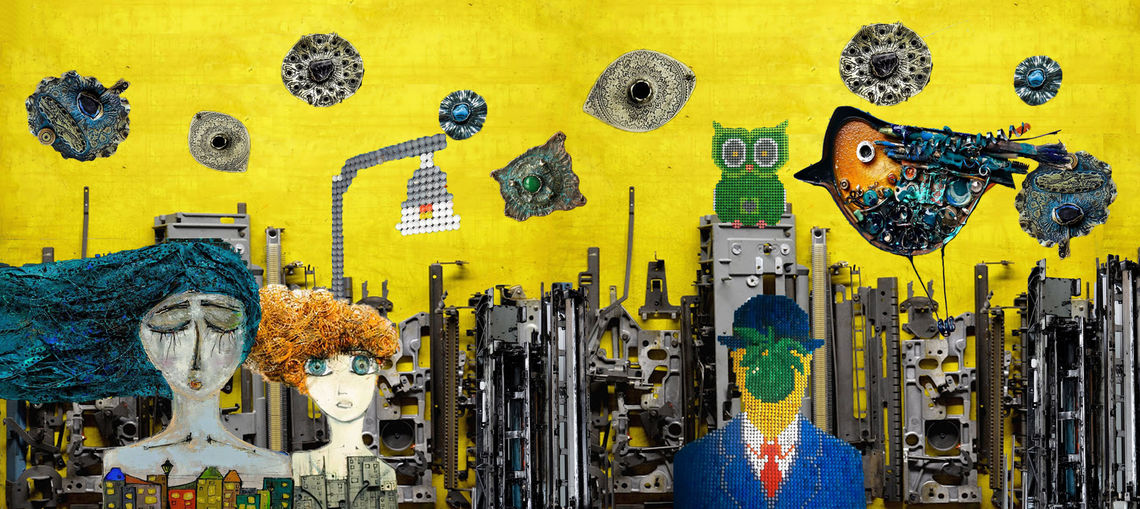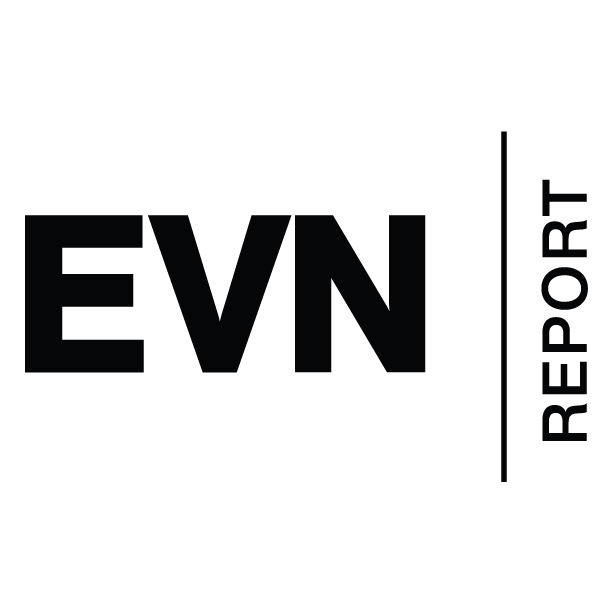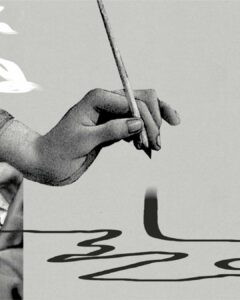

While Armenia is among the countries with the most waste produced per capita, recycling is slowly gaining traction, with several new companies stepping in to divert waste. There are some customers who even pay these companies to take away their recyclables.
In Armenia, where people with endless imagination and creativity put their mind to solving problems, a few are even turning garbage into art.
Arsen Vardanyan: Love and Art in a Resilient City
After the 1988 earthquake, many of Gyumri’s residents were housed in shipping containers, which was meant to be a temporary measure. It was a makeshift solution that was less temporary than many hoped. Today, many of their residents have either received homes or have moved abroad. However, those container-homes, known as domiks, bore witness to both happy and somber days, weddings and losses, and hopes for a better future. Arsen Vardanyan, an expert in international relations and a lawyer by profession, grew up in one of Gyumri’s domiks. He doesn’t live there anymore. One day, while visiting his old neighborhood, he noticed that, though the domiks were gone, there was a scattering of nails left in their place—evidence that the district used to be occupied. Arsen transformed these nails into works of art, a collection he named Memory. A creative mind can find a purpose for any material.
Arsen worked as a journalist for many years. However, he says there came a point when he realized that you “can’t catch a mouse by talking,” a saying that means you have to put your words to action. He realized that Gyumri can be transformed without external financial investment. There were many people in his hometown who were ready to dedicate their free time to restoring the city.
“There are a lot of crazy people in our city that are ready to do something good for Gyumri without pay,” says Arsen. “In the beginning, we decided to restore damaged signs on buildings. We are continuously working in this way to show others that you don’t need to open an NGO to make changes.”
Their army of “crazy ones” grew; people started coming together to find new and innovative solutions. What attracted these enthusiasts was the fact that participants agreed not to have debates and discussions on religion, politics or political parties. Outside the initiative, they were free to do what they wanted. This precondition was meant to underscore that despite everything, Gyumri belongs to everyone, regardless of political views. If someone is helping Gyumri, they are helping everyone.
“One of the founders of our initiative, Gideon Simonyan, created an event page on Facebook and we started sending invites to everyone asking them to collect plastic bottle caps from all over Armenia. To date, we have collected 250,000 bottle caps,” explains Arsen, adding that a lot of people made fun of them, some even sharply criticizing their initiative, which was to create stunning mosaics from the bottle caps.
Their group wants to help the environment while beautifying their city. That is why they don’t install their mosaics and carpet designs made of plastic bottle caps just anywhere. There are certain areas of the city that are deemed to have important historical and cultural heritage which should not be disturbed. But after getting approval from the Gyumri Municipality and negotiating with the city’s residents, the volunteers did decorate the facades of the city’s new buildings with their colorful artwork.
“The volunteers collecting plastic bottle caps were constantly raising concerns about the leftover plastic bottles,” says Arsen. “Our technologist Armen Tumasyan proposed turning the bottles into thread. We decided to tie the caps together with the plastic thread to make our collages.”
When looking at the plastic bottle cap carpets, it’s plain to see the enormous amount of work put into them. First, the volunteers sort the bottle caps by color, and then by size. Then, with the help of the artist, they prepare its initial design. The imaginations of these Gyumretsis have not only reached as far as Goris but also decorate the walls of the Smithsonian Museum in Washington, DC.
“The average piece of art contains 3,500-6,000 plastic bottle caps,” explains Arsen. “We can make one beautiful piece with a ten-person team within four to five days. We have 19 completed pieces, 17 of them in Gyumri.”
The number of tourists visiting Gyumri has increased over the past several years, not only because of the city’s historical and cultural heritage but also its residents, their hospitality and the love and pride they feel for their city and their roots. This initiative has also helped bring more tourists to the city. People come to see the labors of love created by these talented people.
“Our work is inclusive and people as young as three can take part in the process,” explains Arsen. “It’s not tiresome. Also, we are happy when large numbers of tourists come to our workshop. There have been days when we’ve had 250 visitors.”
After working together for years, their group now considers each other like family. They have also restored the tradition of Armenian hol (spinning top) games.
Ani Hovak’s Environmental Art
Flutist and singer Ani Hovak started painting at 22. When she was in school, she would have never imagined that she would pick up painting. She now paints angels and girls, makes graphics and collages. However, before this, she was already making jewelry out of fruit scraps.
“I would take the pits of cherries, peaches and apricots and would make jewelry for my friends,” says Ani. “I’ve always been interested in recycling and thought, if I can make a small contribution to the environment and bring joy to my friends, then why not?”
Ani’s paintings are of beautiful girls with curly, tangled hair, angels, religious icons and birds.
“Waste management has reached a point where it’s impossible to supervise it,” says Ani. “Every single one of us has to take steps to keep our country clean. I would sort my trash with joy and wouldn’t be lazy about it. However, those organizations that recycle in Armenia do it for money.”
Ani’s “favorite” useless material is metal waste, pieces of rusted iron that even the soil could not “swallow” and has stayed rusted like that for years.
“The curls of my girls’ hair are made out of springs from mattresses, which I paint with whatever I have on hand. In this sense I’m flexible – whatever paint is available is what I use for my artwork,” explains Ani. “It’s true, when I would come home with a bunch of waste, the neighbors used to be shocked. But I didn’t pay attention because I knew that my family members understood what I was doing in our home, which I had turned into my studio.”
Ani’s friends often call her to say when they’re cleaning out their attics to ask if she would want the leftover waste. Soon, Ani had collected so much waste and created so many pieces that there was no more room left for her artwork at home. That’s when she moved them to a studio. A filter net in teapots, parts of an accordion, unusable corners of a picture frame, forgotten and faded chess pieces, medicine blister packs, lemonade caps, spools of thread – all of these become works of art in Ani’s hands.
“I am the owner of my art and I like that autonomy. Being independent is very important when you are creating,” explains Ani. “I don’t name my paintings. That’s what I’ve decided and that’s final. Sometimes I’m commissioned to prepare a piece, but if they start telling me how I should make it then I just refuse to do it.”
Ani Hovak can look at waste and know what she can make out of it, or she can decide to paint a bird and know what kind of waste she needs. Though every piece is different, Ani spends two days on average to complete one. She admits that she is impatient and when she starts working, she does it with unnatural speed.
“I paint with watercolors, mascara, oil paints, acrylic. It’s not important what you paint with,” says Ani. “What’s important for me when I work are my emotions, getting what I’m thinking about across. I don’t like complaining when I can’t find a certain color or something else.”
Ani says her work is mixed media, an art form that uses different techniques and materials, although for her, it’s not important what it’s called. What’s important is that we love mother nature.
“I’m happy for mother nature, even though this is a difficult time [due to coronavirus]. However, nature needs to recuperate. We’ve infuriated it, we haven’t let it breathe,” says Ani. “We Armenians are not thoughtful toward the miracle that was given to us. But I see a new generation that is more responsible and caring, a generation that does its grocery shopping with cloth bags, collects trash after themselves when they go on picnics.”
Ani is still creating with an impatient rhythm, consumed by her curly-haired girls, religious icons and birds. And every time a new piece is born, one more corner of nature is saved.
Romeo Melikyan: Assemblage From the Bordertown of Berd
Sunrises in the bordertown of Berd in the Tavush region may be beautiful but they can also be interrupted by gunfire coming from Azerbaijani military posts. It’s difficult to create art in a warzone town without leaving your small piece of land. How can someone need art there, or find time to love and appreciate it? However, one young painter leaves his house at sunrise every day and goes to his studio. Berdtsi Romeo Melikyan is not bothered by his fellow city dwellers who are skeptical about his art.
“Being an artist in our country is not honorable,” says Romeo. “When I tell people I’m an artist, they look at me as if I’m from the lowest class. When I’m abroad and I tell people there I’m an artist, their eyes shine and they look at me with respect. Art is appreciated there.”
Melikyan’s artwork is in “plural form,” portraying crowds, buildings, structures. The notion of plurality has interested him since childhood. He would draw a lot, especially funerals, construction cranes. Now he collects “useless” materials and creates his own multitudes. Romeo says he never consciously collected waste in order to help the environment. One of the reasons he uses waste is because he likes to work with new materials.
“In art, you have to constantly think creatively. That is why I started getting interested in iron materials and metals,” explains Romeo. “Often, when I’m walking through the city and I find a useless thing, I take it to my studio. I might not use it at that moment, but I know that one day it will find its place in one of my pieces.”
People often write to Romeo from abroad about his work. His buyers are exclusively from abroad; he’s never had a buyer from Armenia.
“I have an art piece that looks like abandoned buildings. I used LED lights to make it,” says Romeo. “It took me two days to make those buildings. If I can’t find my muse, it might take a week. It doesn’t matter if it’s a commissioned piece or I decided to create it myself, you need to be in the mood to paint and sculpt.”
He jokes that his friends often tell him to come and haul their junk away. He picks up aluminum and iron materials and takes them to his studio. He takes materials that he can use with his welding machine. His art form is called assemblage, a virtual art technique similar to collage that includes extensive details made out of natural materials
Romeo’s artwork has been part of exhibitions in Serbia, the U.S., Germany, the Netherlands and Armenia. He notes that he’s not good at administrative work. He’s busy creating and can’t find the time to get in touch with museums. Instead, museums find him.
“The size of my artwork is usually around 1.5 to 2 meters. My buyers are usually from the U.S. and Europe,” says Romeo. “They find me online, write to me and I send them my artwork. Unfortunately, in Armenia they don’t ask about my work, I don’t have buyers from my country.”
None of his pieces are in his home. He doesn’t have a favorite or best piece. In general, he’s quite critical of his own work. He’s not only the creator of his work but also its critic.
“It’s difficult for an artist in Berd. There is no atmosphere, nobody who can come and look at your work and say something about it, even if it is to criticize it,” explain Romeo. “I try to fill my days with music and watching movies. For years, they’ve told us we are the keepers of our borders. Our people think we are protecting our borders, what does art have to do with us?”
Artak Tadevosyan: When Weapons are Pacified
“I would often take my children on picnics in the woods, where they would find bullet cases leftover by hunters and would ask what they were,” says Artak Tadevosyan. “I didn’t want to tell them that they were bullets, which people use to shoot animals and often even other people. I would try to find other explanations for them. I wanted to find a second use for guns, a more positive use.”
But can a gun bring peace? All the weapons that fall into jewelry designer Artak Tadevosyan’s hands are pacified. Artak attributes his love of art to his parents. They believed that, by bringing their children closer to art, they would teach them to appreciate other more important values than material needs and they would also cultivate tenderness and good taste.
“I used to go on business trips where we would get orders for sculptures that did not have a trace of art in them. It was simply for subsistence,” says Artak. “Honestly, this was not what I wanted to do; it was just work that had to be done.”
The designer had decided from the beginning that his jewelry was to be intended for women. He was confident that by placing weapons on a woman’s chest it would convey a completely different set of emotions to the person wearing them. Also, when their children ask what they are, they won’t get flustered in answering them.
“I started my work in 2014 in a country where craft of jewelry is at a very high level,” explains Artak. “I can’t stand mediocrity in any work. If a person accepts mediocrity, then they can’t achieve anything. In jewelry design, both expertise and creativity are at the forefront.”
When missile fragments, gun parts and bullets make it to Artak’s hands, they stop posing a threat. As a result of his imagination and dedication, they turn into jewelry. There is no shortage of raw materials unfortunately in Armenia. Sometimes we need to be creative about peace.
“I have art pieces that I’ve completed in a day. And I have other pieces that I’ve been working on for four years and are not yet completed,” says Artak. “There are pieces that I make out of one bullet, there are other pieces that I make out of several bullet cases. Every piece of jewelry is special and demands a special approach and mood.”
An art-loving Gyumretsi, or an American senator – for the artist, they are all equal. For Artak, all his customers are honored no matter what position they hold. His studio is a regular stop for tourists to Gyumri.
“I’ve turned our basement into my studio,” explains Artak. “Whoever visits Gyumri knows that they won’t merely find jewelry here but also history and connection.”
Gyumri is slowly starting to stand on its own two feet and become attractive for many tourists. The reason is not only its historical and cultural heritage but also the locals who never give up. Artak, like his city, was forced to start from nothing. Today, he has turned useless objects into a popular brand. It’s not easy but he has turned down offers from different countries and has decided to stay in Gyumri so he can, in his own way, spread peace throughout the world from his small but big-hearted city. None of Artak’s pieces are duplicated; he will only ever make one of each piece. He has prepared almost a thousand unique pieces, every one of which has its own story. Beautiful Armenian ornaments, stones about which Artak can talk about for hours…
“I’m happy when people are interested in the history and message of my jewelry,” he says.
In his hands, bullets are transformed into crosses and ammunitions of peace. The ammunition of peace symbol was created for Armenian soccer player Henrik Mkhitaryan. Artak believes that many other popular soccer players will join his calls for peace.
When leaving Artak’s studio, you become a little more of a humanitarian, a little more tolerant. You imagine a world where all weapons could be repurposed this way.
Also read
Who is Educating Armenia’s Youth About the Environment?
With no comprehensive environmental curriculum in Armenian schools, individual teachers and NGOs have taken it upon themselves to educate the youth about pressing environmental issues from climate change to recycling.
Read moreHow to Respect, Not Waste, Food
Food waste is a serious global issue. Roughly one third of the food produced globally gets lost or wasted. In fact, most of it ends up in a landfill. What is Armenia doing to tackle this issue?
Read moreArmenia Bans Plastic Bags
The government of Armenia has set the effective date for a ban on plastic bags to January 1, 2022. It is projected that the ban will reduce plastic waste by nearly 4000 tons annually.
Read more



